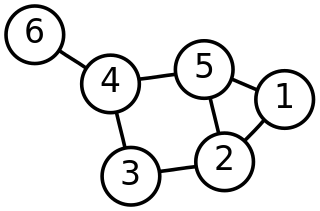Loading AI tools
Subgraph made of all nodes linked to a given node of a graph From Wikipedia, the free encyclopedia
In graph theory, an adjacent vertex of a vertex v in a graph is a vertex that is connected to v by an edge. The neighbourhood of a vertex v in a graph G is the subgraph of G induced by all vertices adjacent to v, i.e., the graph composed of the vertices adjacent to v and all edges connecting vertices adjacent to v.

The neighbourhood is often denoted or (when the graph is unambiguous) . The same neighbourhood notation may also be used to refer to sets of adjacent vertices rather than the corresponding induced subgraphs. The neighbourhood described above does not include v itself, and is more specifically the open neighbourhood of v; it is also possible to define a neighbourhood in which v itself is included, called the closed neighbourhood and denoted by . When stated without any qualification, a neighbourhood is assumed to be open.
Neighbourhoods may be used to represent graphs in computer algorithms, via the adjacency list and adjacency matrix representations. Neighbourhoods are also used in the clustering coefficient of a graph, which is a measure of the average density of its neighbourhoods. In addition, many important classes of graphs may be defined by properties of their neighbourhoods, or by symmetries that relate neighbourhoods to each other.
An isolated vertex has no adjacent vertices. The degree of a vertex is equal to the number of adjacent vertices. A special case is a loop that connects a vertex to itself; if such an edge exists, the vertex belongs to its own neighbourhood.

If all vertices in G have neighbourhoods that are isomorphic to the same graph H, G is said to be locally H, and if all vertices in G have neighbourhoods that belong to some graph family F, G is said to be locally F.[1] For instance, in the octahedron graph, shown in the figure, each vertex has a neighbourhood isomorphic to a cycle of four vertices, so the octahedron is locally C4.
For example:
For a set A of vertices, the neighbourhood of A is the union of the neighbourhoods of the vertices, and so it is the set of all vertices adjacent to at least one member of A.
A set A of vertices in a graph is said to be a module if every vertex in A has the same set of neighbours outside of A. Any graph has a uniquely recursive decomposition into modules, its modular decomposition, which can be constructed from the graph in linear time; modular decomposition algorithms have applications in other graph algorithms including the recognition of comparability graphs.
Seamless Wikipedia browsing. On steroids.
Every time you click a link to Wikipedia, Wiktionary or Wikiquote in your browser's search results, it will show the modern Wikiwand interface.
Wikiwand extension is a five stars, simple, with minimum permission required to keep your browsing private, safe and transparent.